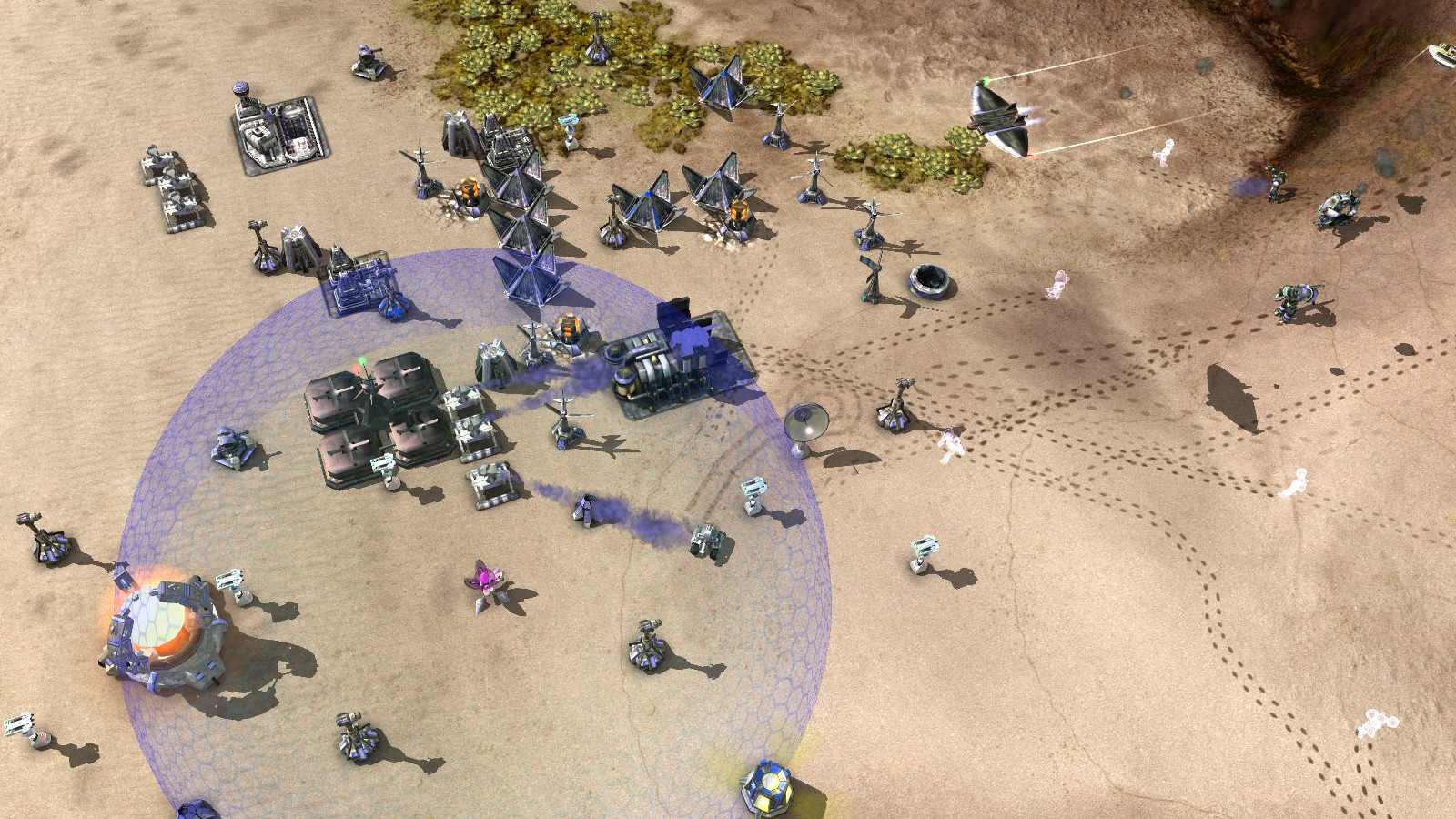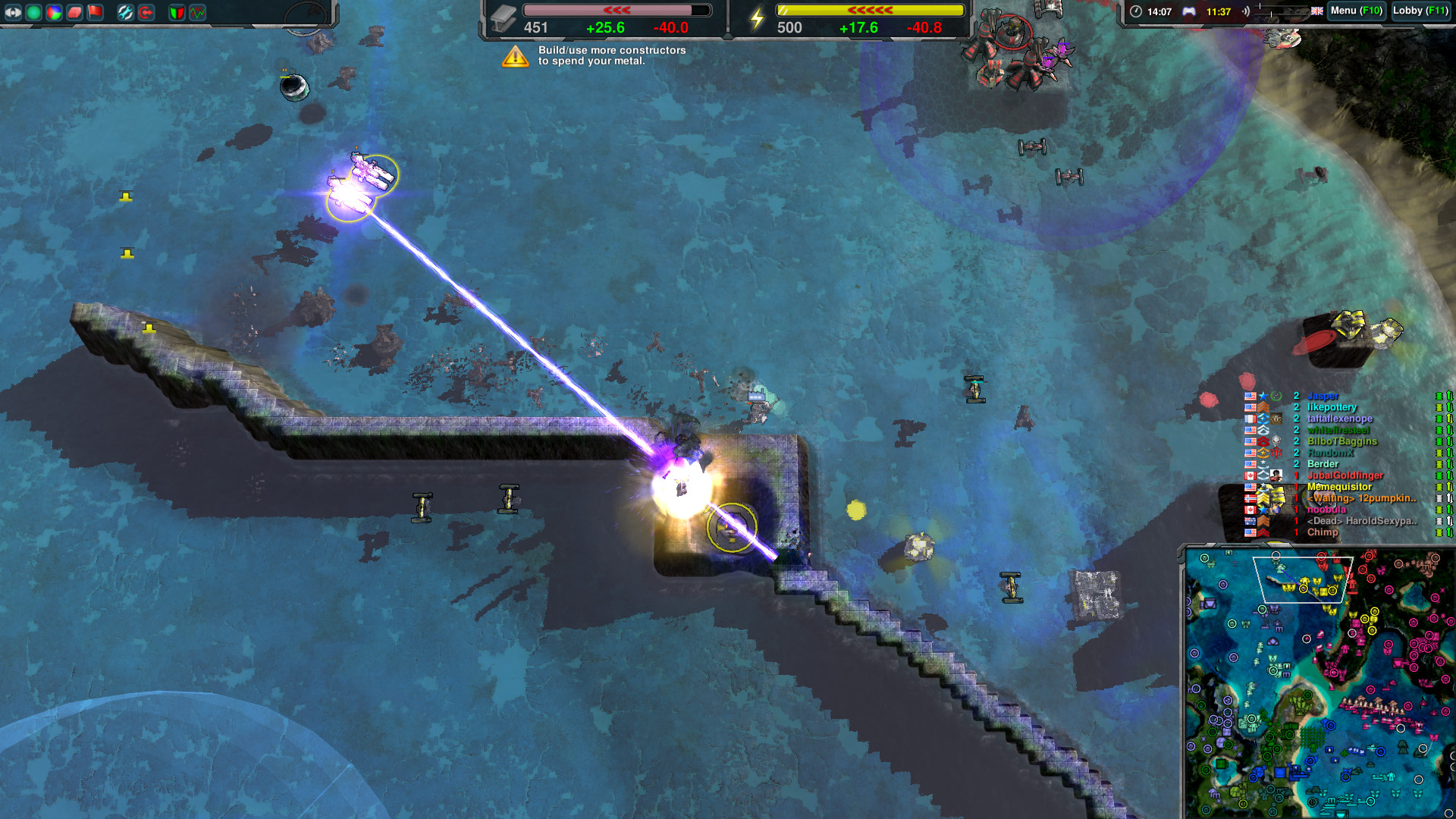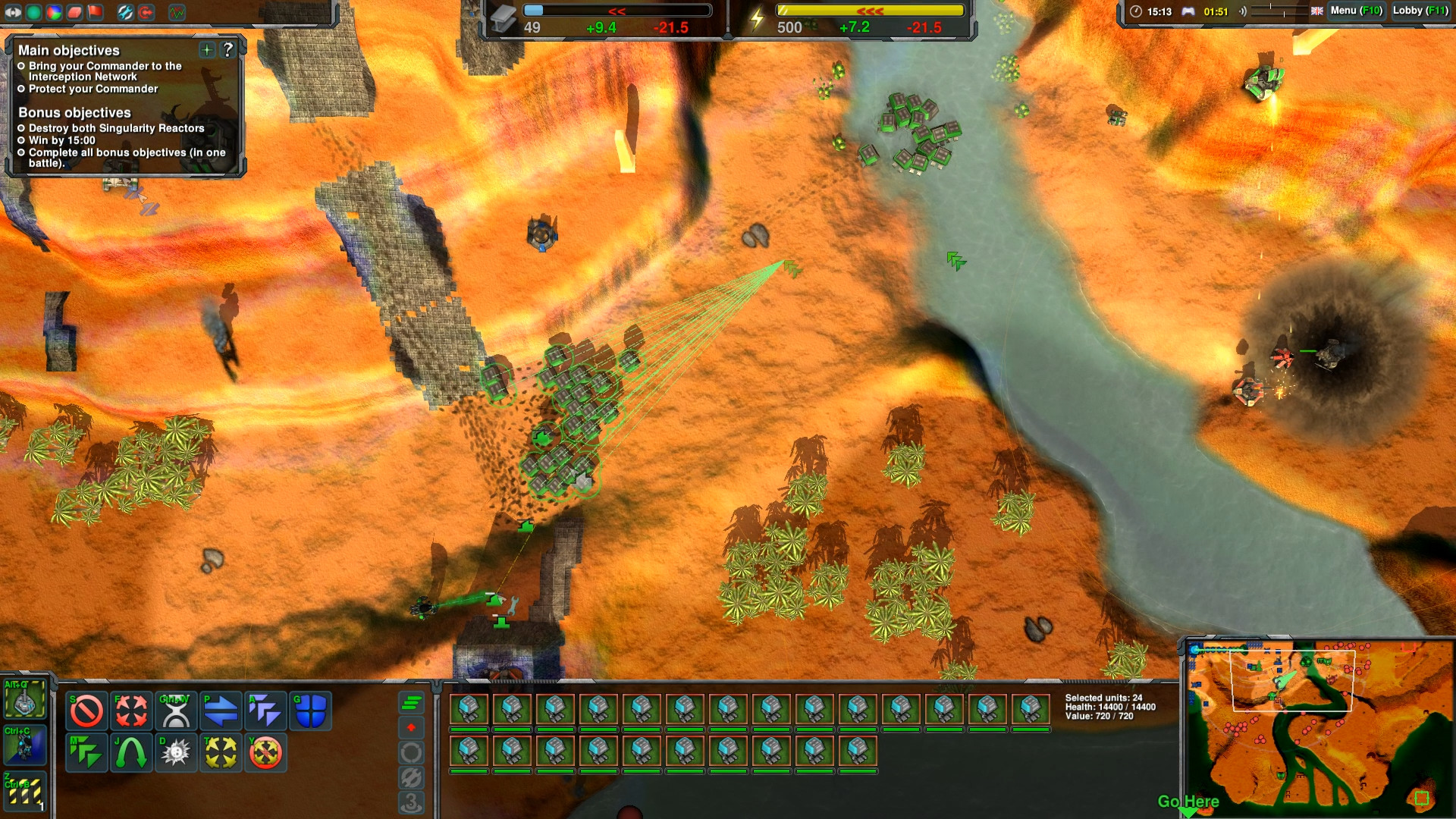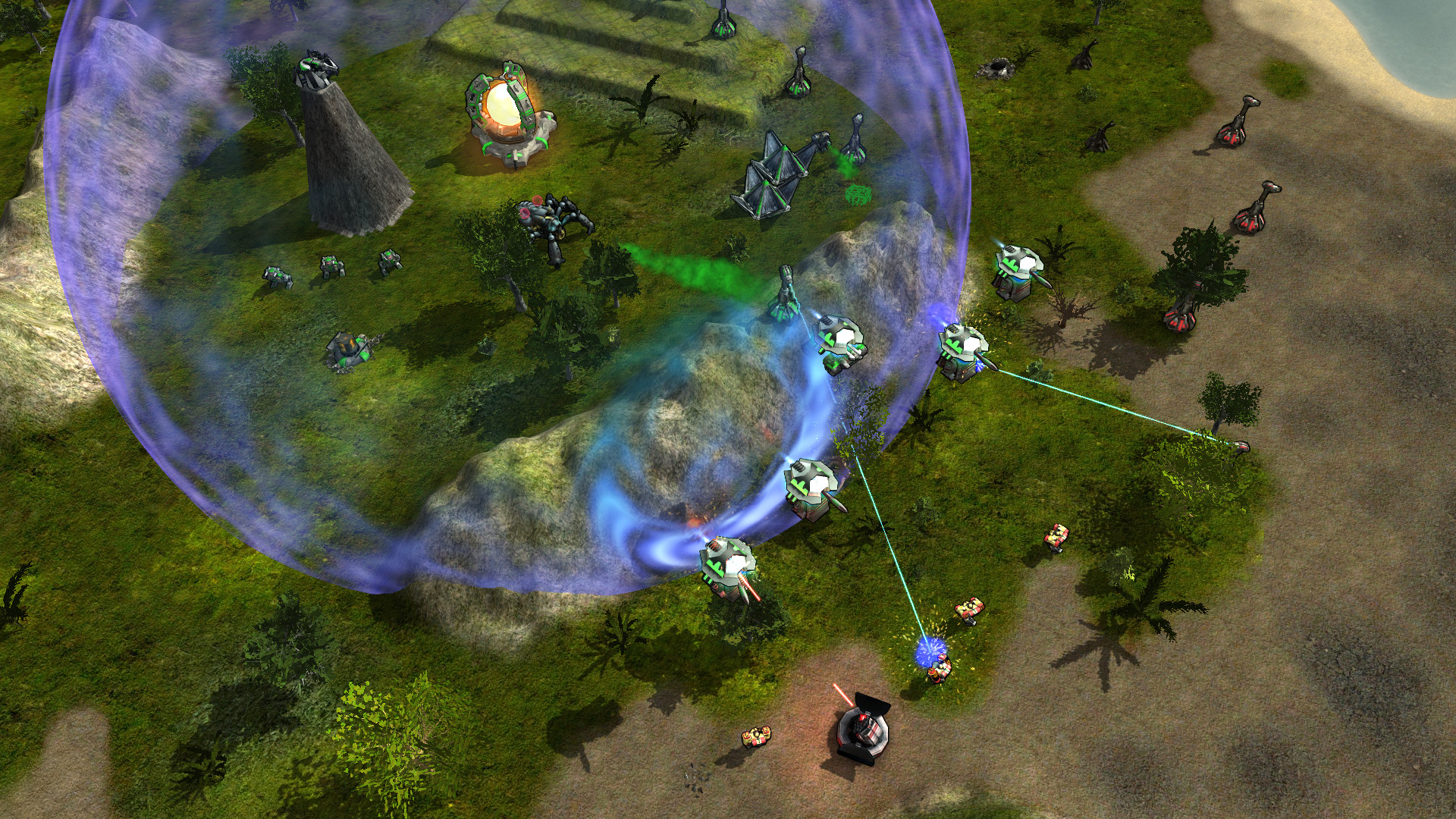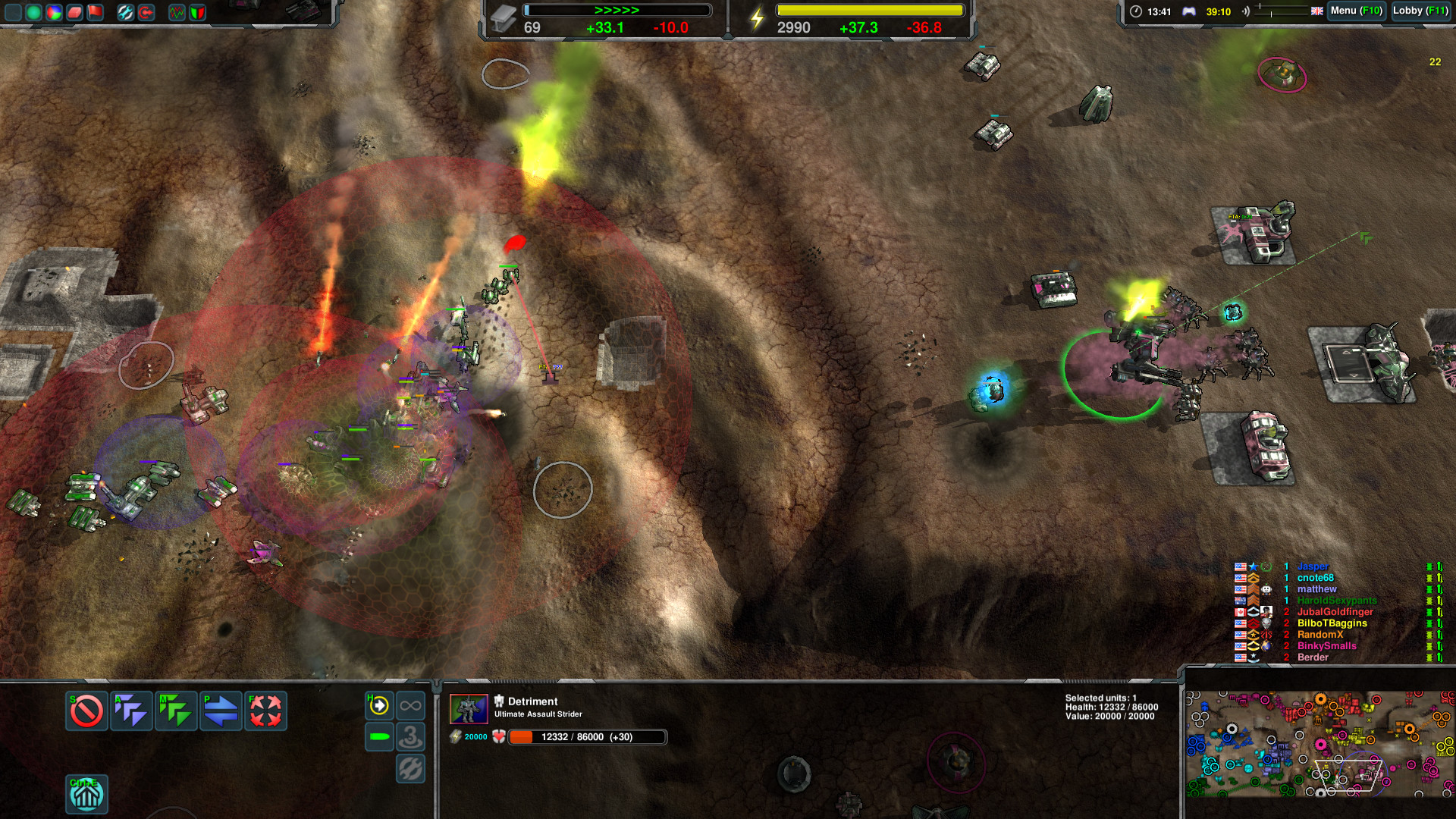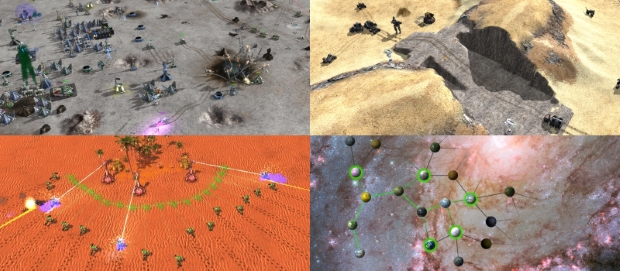
Commander wanted! Construct giant robots, build an army of a thousand Fleas. Move mountains if needed. Bury the enemy at all cost!
- Traditional real time strategy with physically simulated units and projectiles.
- 100+ varied units with abilities including terrain manipulation, cloaking and jumpjets.
- 70+ mission galaxy-spanning campaign to be enjoyed solo or co-op with friends.
- Challenging, (non-cheating) skirmish AI and survival mode.
- Multiplayer 1v1 - 16v16, FFA, coop. ladders, replays, spectators and tournaments.
- PlanetWars - A multiplayer online campaign planned to start in May.
- Really free, no paid advantages, no unfair multiplayer.
Fully Utilized Physics
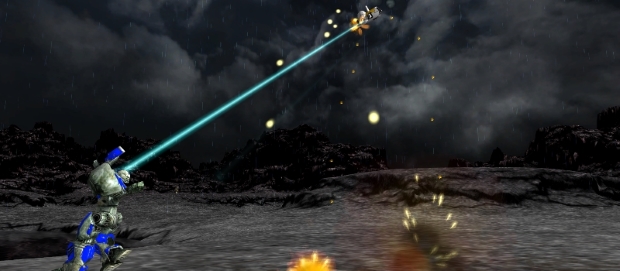
Simulated unit and projectile physics is used to a level rarely found in a strategy game.
- Use small nimble units to dodge slow moving projectiles.
- Hide behind hills that block weapon fire, line of sight and radar.
- Toss units across the map with gravity guns.
- Transport a battleship to a hilltop - for greater views and gun range.
Manipulate the Terrain
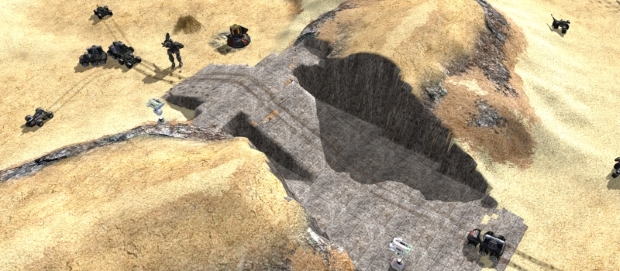
The terrain itself is an ever-changing part of the battlefield.
- Wreck the battlefield with craters that bog down enemy tanks.
- Dig canals to bring your navy inland for a submarine-in-a-desert strike.
- Build ramps, bridges, entire fortress if you wish.
- Burn your portrait into continental crust using the planetary energy chisel.
Singleplayer Campaign and Challenging AI

Enjoy many hours of single player and coop fun with our campaign, wide selection of non-cheating AIs and a survival mode against an alien horde.
- Explore the galaxy and discover technologies in our singleplayer campaign.
- Face a challenging AI that is neither brain-dead nor a clairvoyant cheater.
- Have some coop fun with friends, surviving waves of chicken-monsters.
- Cloaking? Resurrection? Tough choices customizing your commander.
Casual and Competitive Multiplayer
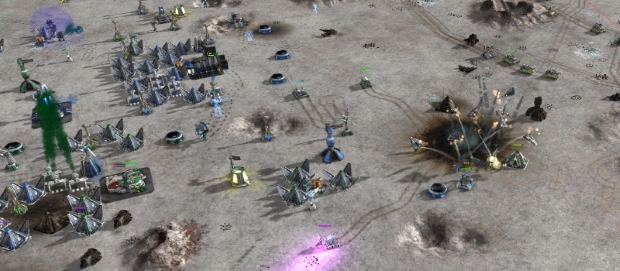
Zero-K was built for multiplayer from the start, this is where you can end up being hooked for a decade.
- Enjoying epic scale combat? Join our 16v16 team battles!
- Looking for a common goal? Fight AIs or waves of chicken-monsters.
- Prefer dancing on a razor's edge? Play 1v1 in ladder and tournaments.
- Comebacks, betrayals, emotions always running high in FFA.
- Want to fight for a bigger cause? Join PlanetWars, a competitive online campaign with web-game strategic elements, diplomacy and backstabbing (currently on hiatus pending an overhaul).
Power to the People
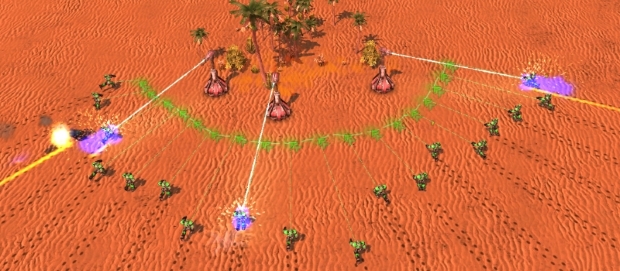
We are RTS players at heart, we work for nobody. We gave ourselves the tools we always wanted to have in a game.
- Do what you want. No limits to camera, queue or level of control.
- Paint a shape, any shape, and units will move to assume your formation.
- Construction priorities let your builders work more efficiently.
- Don't want to be tied down managing every unit movement? Order units to smartly kite, strafe or zig zag bullets.
Plenty of Stuff to Explore (and Explode)
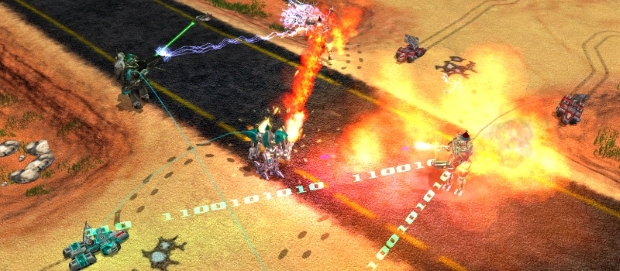
Zero-K is a long term project and it shows, millions hours of proper multiplayer testing and dozens of people contributing ever expanding content.
- Learn to use all of our 100+ units and play on hundreds of maps.
- Invent the next mad team-tactics to shock enemies and make allies laugh.
- Combine cloaking, teleports, shields, jumpjets, EMP, napalm, gravity guns, black hole launchers, mind control and self-replication.
- Tiny flea swarm that clings to walls?
- Jumping "cans" with steam-spike?
- Buoys that hide under water to ambush ships?
- Mechs that spew fire and enjoy being tossed from air transports?
- Carrier with cute helicopters?
- Jumping Jugglenaut with dual wielding gravity guns?
- Meet them in Zero-K!
Serious Strategy Games tend to spread their scope across the three standard theatres of war: air, land, and sea. Zero-K follows suit, despite being markedly more gamey and fun-loving. Nowhere is this clearer than in the interesting application of realism to planes and gunships. The real world has some influence over aircraft behaviour, and very loosely informs their support role, but it is just a starting point. Our priority is for air to be fun and useful throughout the game, as too often it can end up being a bit one-dimensional, or just be relegated to gambits.
First things first, how should air units behave? We were guided by rough intuition, so if it looks about right, then it is right. Real planes exist, but tend to be too high and fast to see, so the average experience of flight probably comes from birds and insects, with a bit of influence from helicopters and drones. These things are fast, so air in Zero-K is fast. Common experience also motivates two types of aircraft movement which, as with ground , we use to sort aircraft into their two factories: Gunships and Planes.

Gunships are akin to helicopters and drones; they fly around, some are quite nimble, and they can all hover in place. This is the standard RTS treatment, and it is sometimes criticised for being unrealistic or for making air and ground combat play out in much the same way. That said, ground combat is solid, and gunship-style air units across many games distinguish themselves by being faster than land units, at least on average. Gunships are also great at attacking from any direction, and avoiding obstacles when trying to retreat.
Planes fly like real aeroplanes and come in three flavours: bombers, fighters, and scouts. They only stop when they land, and have wings, ailerons, and rudders. There is an underlying flight model with the aforementioned parameters, and more, which we use to dial in the realistically uncontrollable feel of planes. Complete Annihilation tweaked these parameters to make planes more controllable than in its predecessors, yet plane-on-plane combat is still quite hard to control, to the point where we avoid expecting people to click on individual fighters, as they are just too fast.
Fast units are troublesome, since they inherently dominate the early game. Speed is just an amazing attribute, especially when there is plenty of free space to move around. Aircraft have it worst, being by far the fastest units, so a lot of air design is focused on how to make them unusually bad early on. Without skewing air away from the early game, we would see it early, then never again.

Planes were nerfed early by requiring bombers to reload after each run. Prior to the change bombers could fly circles over the enemy base, continually bombing it, provided there was no anti-air (AA) in place to shoot them down. This would only realistically happen early in the game, most likely after a surprise attack. Reloading also drains energy , which makes it even more costly early compared to later on.
There is no clean solution to the early game for Gunships, but they are not quite as fast as Planes, so the problem is lessened. Part of their solution is their terrible stats: a gunship will often cost twice as much to move twice as fast, but perform the same, or worse, than land units. Many of them are also awful against raiders, and a bit too expensive to comfortably rush, which adds to their early vulnerability. The light gunships are still in an awkward spot though, and it is made more awkward by AA.
Anti-air is a necessary, yet slightly unfortunate, part of air design. Flying units benefit greatly from Physically simulated projectiles since it lets them avoid most of the damage from a lot of weapons. Even beam weapons, which hit instantly and precisely, either deal constant low damage, or have a sustained burst that only hits fast units for a fraction of their damage. Plus, beams have spherical range , so are bad at shooting up. So Zero-K has units that can only shoot at aircraft, called AA or dedicated AA. This is the largest exception to the idea that units can shoot in any direction they like , but it is a tradeoff that we made to free up the design space for aircraft.

In addition to dedicated AA, Zero-K has flex-AA. This is not a well-defined set of units, rather it is the idea that many units are decent against aircraft, especially if they fly directly overhead. Flex-AA is particularly good against gunships, since they are slower than planes, to the point of making dedicated AA redundant in some cases. In fact, we buffed gunships against dedicated AA on a few occasions. Back in 2010 we reduced plane health and anti-air damage by 25%, which is equivalent to making planes weaker to flex-AA, and gunships stronger against dedicated AA. This was repeated in 2014 with a reduction of 1/11th, since Raven had 1100 health at the time. There is a limit to this approach though, because at some point the most effective flex-AA starts destroying planes.
Dedicated AA poses a potential problem: it is monospammable if you are only facing air. We solve this by declaring the problem to not exist. Planes and Gunship are deliberately designed as support factories, they are not meant to hold a front on their own, and should be unploppable in 1v1 . Of course they technically can be plopped, as to block a plop based on player count would be too arbitrary, so all we can do is discourage them. Gunships were a particular problem for 1v1, since forcing out a bit of AA then quickly switching to land confers a massive advantage. In addition to making their units terrible early, we also had to make their constructor too slow and expensive for early expansion.
Air factories are not like other factories. While land factories are a somewhat self-contained and flexible set of units, air factories only make up one side of a counter triangle. Air beats ground armies, which beats AA, which in turn beats air. So if the enemy makes a lot of AA, then the air player might need to switch to ground to kill the AA. This turns air into a force that escalates the game, as it adds an extra layer of interaction, similar to the relationship between nukes and antinukes . This makes air a bit less of a faction , and more of a tech choice, at least in 1v1.

Even as a secondary factory, built later on to escalate the game, Gunships have had a problem with viability. This is understandable when you realise that Planes offer the fastest units, the best scouts, and can execute devastating surprise bombing runs. Gunships are just a bit faster than ground units, can attack from anywhere, and have terrible stats. The scouting issue in particular motivated the addition of Sparrow: a light scout that can be produced by morphing a radar tower. This gives all factories access to scouting, so adding another land factory is more viable as well, which is a neat way to see cross-factory synergies.
In the end, air is not the primary domain of Zero-K, but it is constantly trying to break out and become the whole game, rather than just be a fleshed-out corner of a counter triangle. This is a lot to put on only twenty or so units, and as a result they are some of the most tweaked and reworked in the game, with Raven out in the lead. Specifics may come in future posts, as they would make this one three times as long.
Index of Cold Takes
Minimum Setup
- OS: Ubuntu 13.04 or equivalent
- Processor: 2.0 GHz dual core CPU with SSE (Intel Core 2 Duo or equivalent)Memory: 4 GB RAM
- Memory: 4 GB RAM
- Graphics: 512 MB graphics card with OpenGL 3 support (GeForce 8800 or equivalent)
- Storage: 6 GB available spaceAdditional Notes: 64bit only. Big Picture mode is not supported
Recommended Setup
- OS: Ubuntu 17.10 or equivalent
- Processor: 3.0 GHz quad core CPU (Intel Core i5 or equivalent)Memory: 8 GB RAM
- Graphics: 2048 MB graphics card with OpenGL 3 support (high GT 500 series or equivalent)Network: Broadband Internet connection
- Storage: 8 GB available spaceAdditional Notes: 64bit only. Big Picture mode is not supported
[ 6486 ]
[ 1519 ]
[ 2422 ]

